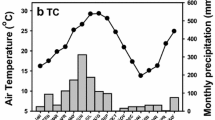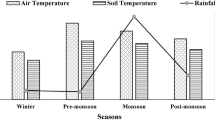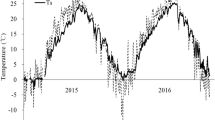Abstract
Soil incubation experiments were conducted in lab to delineate the effect of soil temperature and soil water content on soil respirations in broad-leaved/Korean pine forest (mountain dark brown forest soil), dark coniferous forest (mountain brown coniferous forest soil) and erman's birch forest (mountain soddy forest soil) in Changbai Mountain in September 2001. The soil water content was adjusted to five different levels (9%, 21%, 30%, and 43%) by adding certain amount of water into the soil cylinders, and the soil sample was incubated at 0, 5, 15, 25 and 35°C for 24 h. The results indicated that in broad-leaved/Korean pine forest the soil respiration rate was positively correlated to soil temperature from 0 to 35°C. Soil respiration rate increased with increase of soil water content within the limits of 21% to 37%, while it decreased with soil water content when water content was over the range. The result suggested the interactive effects of temperature and water content on soil respiration. There were significant differences in soil respiration among the various forest types. The soil respiration rate was highest in broad-leaved/Korean pine forest, middle in erman's birch forest and the lowest in dark coniferous forest. The optimal soil temperature and soil water content for soil respiration was 35°C and 37% in broad-leaved/Korean pine forest, 25°C and 21% in dark coniferous forest, and 35°C and 37% in erman's birch forest. Because the forests of broad-leaved/Korean pine, dark coniferous and erman's birch are distributed at different altitudes, the soil temperature had 4–5°C variation in different forest types during the same period. Thus, the soil respiration rates measured in brown pine mountain soil were lower than those in dark brown forest and those measured in mountain grass forest soil were higher than those in brown pine mountain soil.
Similar content being viewed by others
References
Behera, N., Pati, D.P. 1986. Carbon budget of protected tropical grassland with reference to primary production and total soil respiration [J]. Rev. Ecol. Biol. Soil.,23: 167–181.
Chen Siqing, Cui Xiacyong, Zhou Guangshenget al. 1999. Study on the CO2-release rate of soil respiration and litter decompositionStoa grandis Steppe in Xilin river basin, Inner Mongolia [J]. Acta Bot. Sin.,41(6):645–650. (in Chinese)
Cheng Borong, Xu Guangshan, Ding Guifanget al. 1981. The main soil groups and their properties of the natural reserve on northern slope of Changbai Mountain [C]. In: Research of Forest Ecosystem (2). Beijing: China Forestry Publishing House, p196–206. (in Chinese)
Davidson, E.A., Belk, E., and Boone, R.D. 1998. Soil water content and temperature as independent or confounded factors controlling soil respiration in a temperature mixed hardwood forest. Global Change Biol., 4:217–227.
De Jong, E., Schappert, H.J.V., Macdonald, K.B. 1974. Carbon dioxide evolution from virgin and cultivated soil as affected by management practices and climate [J]. Can. J. Soil. Sci.,54: 299–307.
Fang Jingyun, Piao Shilong, Zhang Shuqing. 2001. The carbon sink: The role of the middle and high latitudes terrestrial ecosystems in the northern hemisphere [J]. Acta Phytoecol. Sin.,25(5):594–602. (in Chinese)
Fang Jingyun, Wei Chuhua. 1998. Carbon cycle in the arctic terrestrial ecosystems in relation to the global warming [J]. Acta Sci. Circ.,18: 113–121. (in Chinese)
Gupta, S.R., Singh, J.S. 1981. Soil respiration in tropical grassland [J]. Soil Biol Biochem,13: 261–268.
Jenkinson, D.S., Adams, D.E. & Wild, A. 1991. Model estimates of CO2 emission from soil in response, to global warming [J]. Nature,351: 304–306.
Krischbaum, N.U.F. 1995. The temperature of soil organic matter decomposition and the effect of global warming on soil organic storage [J]. Soil Boil Biochem.,27: 735–760.
Kucera, C., Kirlcham, D. 1971. Soil respiration studies in tallgrass prairie in Missouri [J]. Ecology,52:912–915.
Lavigne, M.B. 1987. Differences in stem respiration responses to temperature between balsam fir trees in thinned and unthinned stands [J]. Tree Physiol.,3:225–233.
Li Wenhua, Deng Kunmei, Li Fei. 1981. Study on Biomass and primary production of the main ecosystems in Changbai Mountain [C]. In: Research of Forest Ecosystem (2). Beijing: China Forestry Publishing House, p 34–50. (in Chinese)
Liu Shaohui, Fang Jingyun. 1997. Effect factors of soil respiration and the temperature's effects on soil respiration in the global scale [J]. Acta Ecol. Sin.,17(5):469–476. (in Chinese)
Moore, T.R., Dalva, M. 1993. The influence of temperature and water table position on carbon dioxide and methane emissions from laboratory columns of peat land soils [J]. J. Soil Sci.,44:651–664.
Moore, T.R., Knowles, R. 1989. The influence of water table levels on methane and carbon dioxide emissions from peat land soils [J]. Can J. Soil Sci.,69:33–38.
Rainch, J.W., Schlesinger, W.H. 1992. The global carbon dioxide flux in soil respiration and its relationship to vegetation and climate [J]. Tellus,44:81–99.
Robert, E.S., Keith, V.C. 1985. Relationships between CO2 evolution from soil, substrate temperature, and substrate water content in four mature forest types in interior Alaska [J]. Can. J. For. Res.,15: 97–106.
Schlesinger, W.H. 1997. Biogeochemistry: An analysis of global change [M]. San Diego, California: Academic Press.
Singh, J.S., Gupa, S.R. 1997. Plant decomposition and soil respiration in terrestrial ecosystems [J]. Bot. Rev.,43:449–528.
Upadhyaya, S.D., Siddiqui, S.A., Singh, V.P. 1981. Seasonal variation in soil respiration of certain tropical grassland communities [J]. Trop Ecol.,22:157–161.
Wildung, R.E., Garland T.R., Buschbom, R.L. 1975. The interdependent effects of soil temperature and water content on soil respiration rate and plant root decomposition in arid grassland soils [J]. Soil Biol. Biochem.,7:373–378.
Xu Guanghui, Zheng Hongyuan, Zhang Desheng. 1980. Distribution of soil microorganisms under different forest types in the Changbaishan Natural protective area [C]. In: Research of Forest Ecosystem (1). Beijing: China Forestry Publishing House, p153–160. (in Chinese)
Xu Guangshan, Ding Guifang, Zhang Yuhuaet al. 1980. A primary study on soil humus and its characteristics in main forests on northern slope of Changbai Mountain [C]. In: Research of Forest Ecosystem (1). Beijing: China Forestry Publishing House, p 215–220. (in Chinese)
Yang Jingchun. 1989. The seasonal variation of respiration rate of soil microorganisms related to soil temperature and water content on theLeymus chinesis grassland in northeast China [J]. Acta Ecol. Sin.,9(2):139–143. (in Chinese)
Author information
Authors and Affiliations
Corresponding author
Additional information
Foundation item: This study was supported by grant from the National Natural Science Foundation of China (No. 30271068), the grant of the Knowledge Innovation Program of Chinese Academy of Sciences (KZ-CX-SW-01-01B-12) and the grant from Advanced Programs of Institute of Applied Ecology Chinese Academy of Sciences.
Biography: WANG Miao (1964-), male, associate professor in Institute of Applied Ecology, Chinese Academy of Science, Shenyang 110016, P. R. China.
Responsible editor: Song Funan
Rights and permissions
About this article
Cite this article
Miao, W., Qiu-rong, L., Dong-mei, X. et al. Effects of soil temperature and soil water content on soil respiration in three forest types in Changbai Mountain. Journal of Forestry Research 15, 113–118 (2004). https://doi.org/10.1007/BF02856744
Received:
Issue Date:
DOI: https://doi.org/10.1007/BF02856744




